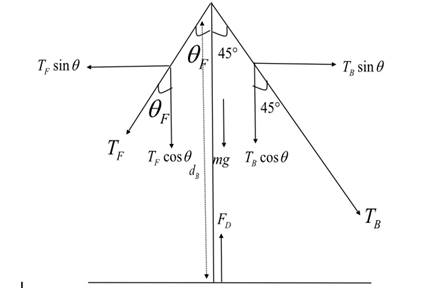
Concept explainers
To Find:The tension in the backstay and the normal force that the deck exerts on the mast.
Answer to Problem 17P
The tension in thee backstay is
The normal force exerted by the deck on the mast is
Explanation of Solution
Given data:
Free body diagram for the given situation is as follows:

Formula used:
Apply the condition of translational and
Calculation:
Apply the condition of rotational equilibrium to the mast. The net torque due to tension by the wires is equal to zero and is represented as:
Torque due to the left side of the pole is given as
Torque due to right side of the pole is given as
Since the torque due to right side of the wire is in clock wise direction, it is negative.
Thus, the torque of horizontal components according to the condition of rotational equilibrium is given as
Here,
Substitute
From the figure, angle of forestay is obtained as follows:
Here,
Substitute
Determine the tension in the backstay as below.
Substitute the
Therefore, the tension in the backstay is
Torque due to the left side of the pole is given as,
Torque due to right side of the pole is given as,
Since the torque due to right side of the wire is in clock wise direction, it is negative.
Thus, the net torque of vertical components according to the condition of rotational equilibrium is given as,
Here,
Re-arrange the above equation for
Substitute
Conclusion:
The normal force exerted by the deck on the mast is
Want to see more full solutions like this?
Chapter 12 Solutions
PHYSICS F/SCI.+ENGRS.,STAND.-W/ACCESS
- Hi! I need help with these calculations for part i and part k for a physics Diffraction Lab. We used a slit width 0.4 mm to measure our pattern.arrow_forwardExamine the data and % error values in Data Table 3 where the angular displacement of the simple pendulum decreased but the mass of the pendulum bob and the length of the pendulum remained constant. Describe whether or not your data shows that the period of the pendulum depends on the angular displacement of the pendulum bob, to within a reasonable percent error.arrow_forwardIn addition to the anyalysis of the graph, show mathematically that the slope of that line is 2π/√g . Using the slope of your line calculate the value of g and compare it to 9.8.arrow_forward
- An object is placed 24.1 cm to the left of a diverging lens (f = -6.51 cm). A concave mirror (f= 14.8 cm) is placed 30.2 cm to the right of the lens to form an image of the first image formed by the lens. Find the final image distance, measured relative to the mirror. (b) Is the final image real or virtual? (c) Is the final image upright or inverted with respect to the original object?arrow_forwardConcept Simulation 26.4 provides the option of exploring the ray diagram that applies to this problem. The distance between an object and its image formed by a diverging lens is 5.90 cm. The focal length of the lens is -2.60 cm. Find (a) the image distance and (b) the object distance.arrow_forwardPls help ASAParrow_forward
 University Physics Volume 1PhysicsISBN:9781938168277Author:William Moebs, Samuel J. Ling, Jeff SannyPublisher:OpenStax - Rice University
University Physics Volume 1PhysicsISBN:9781938168277Author:William Moebs, Samuel J. Ling, Jeff SannyPublisher:OpenStax - Rice University Principles of Physics: A Calculus-Based TextPhysicsISBN:9781133104261Author:Raymond A. Serway, John W. JewettPublisher:Cengage Learning
Principles of Physics: A Calculus-Based TextPhysicsISBN:9781133104261Author:Raymond A. Serway, John W. JewettPublisher:Cengage Learning Glencoe Physics: Principles and Problems, Student...PhysicsISBN:9780078807213Author:Paul W. ZitzewitzPublisher:Glencoe/McGraw-Hill
Glencoe Physics: Principles and Problems, Student...PhysicsISBN:9780078807213Author:Paul W. ZitzewitzPublisher:Glencoe/McGraw-Hill Physics for Scientists and Engineers: Foundations...PhysicsISBN:9781133939146Author:Katz, Debora M.Publisher:Cengage Learning
Physics for Scientists and Engineers: Foundations...PhysicsISBN:9781133939146Author:Katz, Debora M.Publisher:Cengage Learning College PhysicsPhysicsISBN:9781938168000Author:Paul Peter Urone, Roger HinrichsPublisher:OpenStax College
College PhysicsPhysicsISBN:9781938168000Author:Paul Peter Urone, Roger HinrichsPublisher:OpenStax College Physics for Scientists and Engineers, Technology ...PhysicsISBN:9781305116399Author:Raymond A. Serway, John W. JewettPublisher:Cengage Learning
Physics for Scientists and Engineers, Technology ...PhysicsISBN:9781305116399Author:Raymond A. Serway, John W. JewettPublisher:Cengage Learning





